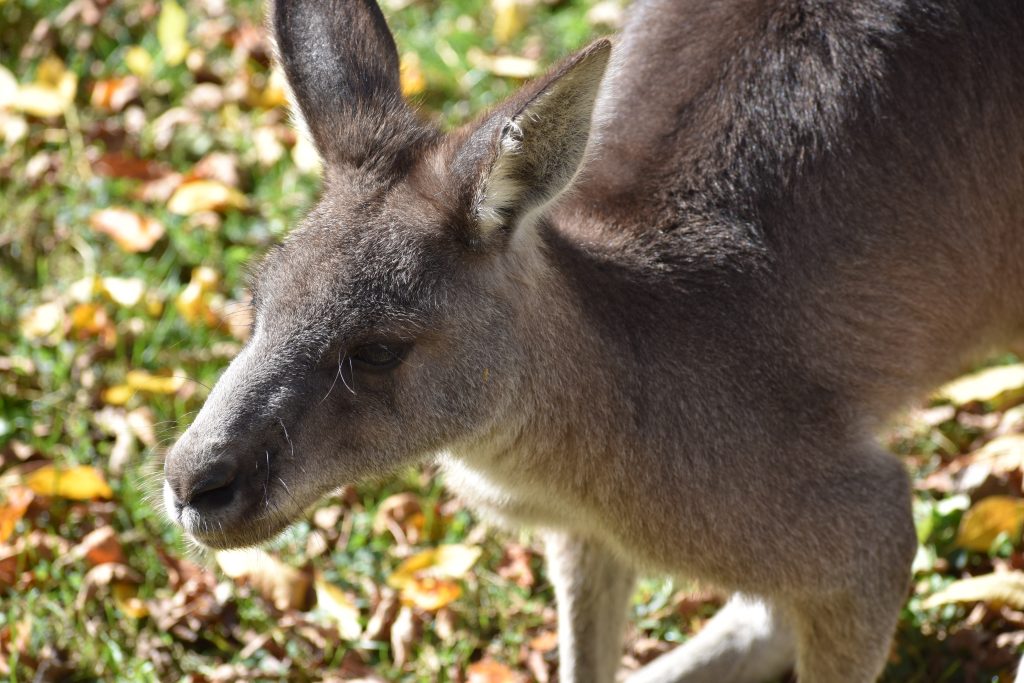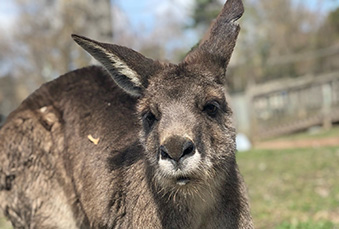Macropus giganteus | Eastern grey kangaroo
Names: Harley (Male)



Meet Harley
Hop into adventure with Harley, our Eastern Grey Kangaroo and Outback ambassador here at the Zoo! He is are almost always seen lounging in the sun, grazing on hay, or bounding over to his keepers for his favorite treat: peanuts!
With sleek silver-gray fur, gentle personalities, and incredible athleticism, Harley represent one of Australia's most iconic animals—and he's got some wild adaptations to prove it.
Built to Bounce
Eastern Grey Kangaroos are the second-largest species of kangaroo, only surpassed in size by the Red Kangaroo. But don’t let their chilled-out vibe fool you—they’re designed for action.
- Top Speed: Up to 35 mph in short bursts
- Jump Distance: A single leap can reach 30 feet—about the length of a school bus
- Tail Power: That thick, muscular tail? It acts as a third leg, helping support their weight while walking, sitting, or grazing
- No Reverse: Kangaroos can’t walk backward and don’t run—they bounce, bound, and balance like no other animal
Survival Experts
Australia is famous for its challenging climate, but kangaroos thrive thanks to their incredible adaptations:
- Thick fur insulates against both hot days and chilly nights
- They lick their forearms to cool down through evaporation
- They conserve water by producing concentrated urine
- Their digestive systems allow them to extract maximum nutrients from dry, fibrous grasses
- Long eyelashes protect their eyes from dust and debris on windy plains
Harley is living proof that evolution knows what it's doing.
Marsupial Magic
Kangaroos belong to a special group of mammals called marsupials, meaning females raise their young in a pouch after birth.
A newborn joey is smaller than a jellybean—hairless, blind, and totally dependent
After crawling into the pouch, the joey nurses and grows for about 11 months
Even after leaving the pouch, joeys may return for extra feedings or comfort
Marsupials evolved in isolation on the Australian continent, and today, over 70% of the world’s marsupial species live there—including kangaroos, wallabies, wombats, koalas, and more.
Kangaroo Country
Eastern Grey Kangaroos are found across eastern Australia, from the island of Tasmania to the Cape York Peninsula. They thrive in:
- Open woodlands
- Grasslands
- Forested areas with at least 10 inches of annual rainfall
Although classified as Least Concern, they are protected under Australian law. In some areas, controlled harvesting for commercial export is allowed under strict regulations.
And yes, kangaroos are so iconic that they appear on the Australian Coat of Arms, alongside the emu. Why? Neither animal can walk backward, making them a national symbol of progress and forward momentum.
What’s for Lunch?
Kangaroos are herbivores, which means that they consume plants. In the wild, Eastern Greys forage for grasses, leaves, bark, and shrubs.
At the zoo, Harley enjoys:
- Mazuri® kangaroo food
- Fresh apples and carrots
- Hay
- And of course—peanuts as a special enrichment treat!
Eastern Grey Kangaroos like Harley help us understand the incredible diversity of life adapted to Australia’s rugged landscapes. Whether you're learning about marsupials, amazed by their movement, or just enjoying their goofy personalities, this guy is a must-see on your zoo visit.
Fact Sheet
Taxonomy
Genus: Macropus | Species: giganteus |
Kingdom: Animalia | Phylum: Chordata | Class: Mammalia | Order: Diprotodontia | Family: Macropodidae |
Favorite Enrichment Type
Peanuts!
Life Span
- In the Wild: About 10 years
- In Human Care: 20+ years
Diet
- In the Wild: Grasses, leaves, tree bark, and shrubs
- At the Zoo: Mazuri® kangaroo food, apples, carrots, hay, and peanuts as a special treat
Geographic Range
Eastern Australia from Tasmania to Cape York Peninsula.
Habitat
Eastern grey kangaroos inhabit diverse environments across eastern Australia and Tasmania, including grasslands, woodlands, and forests. They thrive in regions receiving over 10 inches of annual rainfall.
Kangaroo Fast Facts
- Native to eastern Australia and Tasmania
- Their genus, Macropus, means “big foot” in Greek
- Most active at dawn and dusk (they’re crepuscular)
- A group is called a mob, troop, or court
- Can’t walk backwards or run like other animals
- Marsupials—specialized mammals that raise young in a pouch
- Use evaporative cooling by licking their forearms
Status: Least Concern
International Union for Conservation of Nature (IUCN) — Least Concern (Are a protected species but can be commercially harvested for export by licensed hunters.)
As with all native Australian wildlife, exportation of kangaroos is controlled by the Australian government. Overall, the Eastern grey kangaroo is not in danger of extinction as there are an estimated 1.5 million in the wild. However, some sub-species are listed as endangered or near threatened.
Threats to these animals are habitat destruction and large-scale killing by farmers, as kangaroo’s graze on the same land as sheep.
How to Find Me
Head over to The Outback, located next to the Miniature Horse habitat, and you’ll spot Harley soaking up the sun or showing off his world-class hops. Don’t miss a chance to learn about his care, adaptations, and why kangaroos are such an important part of Australia’s wild identity.
